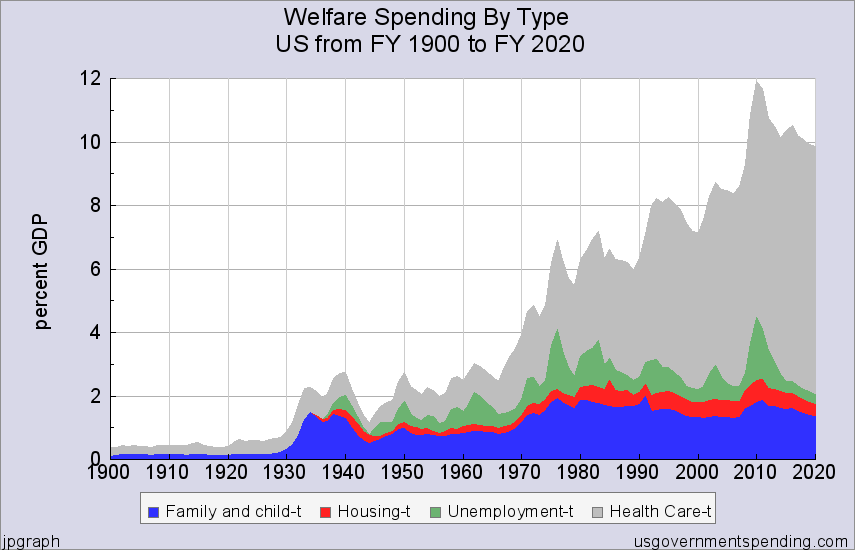
The most popular flavors of the national debate in America today: immigration, healthcare, the Federal debt, and the budding trade war. The American welfare state is the common denominator in each of these quandaries and is the political quagmire which will derail any viable solution for these hot button issues.
The modern American welfare state was effectively borne of the New Deal. It came into being with President Franklin Roosevelt’s words, “Necessitous men are not free men.” It was grand-sired by Woodrow Wilson’s intellectual rejection of the US Constitution. Thanks to a widely misconstrued understanding of the “general welfare” and “charity,” the welfare state has grown into the largest seen in human history. Welfare programs and mandatory interest payments are expected to absorb roughly 60% of total federal spending (excel) this year – more than doubling the estimated 2018 deficit (.pdf). Thus, it’s no wonder this economic millstone has translated into so many different problems.
Illegal immigration, as much as it invades the daily news cycle, is more a correlative symptom of the welfare state than a problem in and of itself. Welfare spending has grown in a series of plateaus. The first began in the 1930s with FDR’s New Deal, and the second coincided with LBJ’s Great Society in the 1960s.
Shortly before, during, and immediately following the New Deal era, there was a decrease in legitimate immigration (which is important as illegal immigration estimations tend to correlate with actual measured immigration numbers). This decrease likely due to the Johnson-Reed Act of 1924 coupled with the U.S. job market during and immediately after the Great Depression. If you also include a series of large, global wars, which were often fought with conscripted soldiers, the first two-thirds of the 20th century would obviously not be the most popular time to move to the US.
Starting at about 1970, after the Great Society programs had taken hold and as the Vietnam War began to wind down, immigration (both legitimate and unauthorized) began to dramatically increase. There was a similar rate of growth in Medicaid vendor payments during this same period of time. Although concurrent growth does not necessitate correlation or causality, it seems that Medicaid spending and immigration at least correlate relative to incentives to immigrate among specifically the low-skilled. As it turns out, people immigrate to take advantage of better opportunities, including “free” money and public services.
Speaking of “free” public services, in the second entitlement plateau of the 1960s, LBJ’s Great Society policies included the guaranteed health insurance program – again referring to Medicaid. Healthcare costs subsequently began to skyrocket, more than doubling as a percentage of GDP by 2014 (excel). However, Medicaid creates a moral hazard, or the “lack of incentive to guard against risk where one is protected from its consequences, e.g., by insurance.”
Insurance is particularly affected by moral hazard, and government-backed insurance especially so. These perverse incentives have led to considerable waste and excess within healthcare markets, which were exacerbated further by the activities of insurance companies and the more recent Affordable Care Act. The welfare state strikes again! But this time it has negatively affected the average American’s ability to access healthcare. In other words, the welfare state doesn’t simply add spice to the daily news cycle, it might actually kill you.
So, logically, everyone has accepted the welfare state as the culprit, right? Unfortunately, this has not been the case. Even conservatives are joining the fray in hopes of expanding it further by restricting free trade through tariffs. As we have all been told, America is not getting a “fair deal” on the world market. U.S. manufacturing has “suffered greatly” at the hands of the Chinese and others who have taken advantage of the US through trade deals, confiscation of intellectual property, and monetary manipulation. All of this is seemingly despite an increase in American manufacturing productivity to the tune of approximately 80% since 1990.
Rather than seeking to address the problem, numerous allegedly “fiscally responsible” and “pro free-market” conservatives have begun to harrumph for tariffs – import taxes that increase the market price of particular goods within the American market. To be clear, these are increased prices that only Americans will pay to subsidize a small portion of American industrial companies like steel and aluminum manufacturers. This is what traditional “free-market” conservatives refer to as “corporate welfare.”
As each new story passes by, it is amazing so few people are addressing the very real problem – the American welfare state. I am hard pressed to find a major story in the news today which does not connect with this quite ubiquitous concern. Where are the intrepid, fiscally responsible conservatives? Where are the sharp, unyielding libertarians or economically sane moderate progressives? There is an objective truth here which certainly applies: all solutions fail which fail to address the problem.